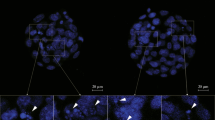Summary
The developmental toxicity of pineal hormones on mouse embryos was examined both in vitro and in vivo. Pregnant ICR mice were divided into groups which received at 1.5 days post-coitum (p.c.) and again at 2.5 days p.c. a subcutaneous injection of one of the following pineal indoles: hydroxyindoleacetic acid (HIAA), melatonin (MEL), methoxytryptophol (MTP) or methoxytryptamine (MTA). Mice treated with the injection vehicle served as the control. The animals were sacrificed at 17.5 days p.c. The pineal indole treatment did not cause changes in the gravid uterine weight, numbers of implants, early resorption, late resorption, dead fetuses and live fetuses, fetal weight or fetal crown-rump length, and did not produce embryos with external or visceral defects. However, some mice treated with MTP or MTA produced litters in which all embryos underwent resorption.
Cultured embryos at the 4-cell stage were treated with the aforementioned pineal indoles and examined after 24, 48, 72, and 96 hours. It was found that MTA retarded embryonic development at all time points studied. HIAA also produced a slight inhibitory effect on embryonic development. Some embryos underwent degeneration in response to the MTA and HIAA treatments. However, MEL- and MTP-treated embryos were in general developmentally similar to control embryos. When cultured embryos were treated at the 8-cell to compacting stage, it was found that MTA exerted only a slight retarding effect on embryonic development, while other indoles were devoid of any conspicuous effects.
Similar content being viewed by others
References
Berga SL, Mortola JF, Yen SSC (1988) Amplification of nocturnal melatonin secretion in women with functional hypothalamic amenorrhea. J Clin Endocrinol Metab 66: 242–244
Braude PR (1979) Time-dependent effect of α-amanitin on blastocyst formation in the mouse. J Embryol Exp Morph 52: 193–202
Brzezinski A, Lynch HJ, Seibel MM, Deng MH, Nader TM, Wurtman RJ (1988) The circadian rhythm of plasma melatonin during the normal menstrual cycle in amenorrheic women. J Clin Endocrinol Metab 66: 891–895
Chan WY, Ng TB (1994) Effects of pineal indoles on ovarian response to gonadotropininduced ovulation in mice. J Neural Transm (in press)
Goldman MD (1983) The physiology of melatonin in mammals. Pineal Res Rev 1: 145–182
Ng TB (1987) Effects of pineal indoles on corticosterone and aldosterone production by isolated rat adrenal cells. Biochem Int 14: 635–641
Ng TB, Wong CM (1986) Effects of pineal indoles and arginine vasotocin on lipolysis and lipogenesis in isolated adipocytes. J Pineal Res 3: 55–66
Ng TB, Lo LLH (1988) Inhibitory actions of pineal indoles on steroidogenesis in isolated rat Leydig cells. J Pineal Res 5: 229–243
Ng TB, Chan WY (1993) Action of pineal indoleamines on the reproductive systems of the male C57 mouse and golden hamster. J Neural Transm [Gen Sect] 93: 99–107
Ooi VEC, Ng TB (1989) Effect of pineal indoles on testicular histology of mice. Arch Androl 25: 127–135
Ooi VEC, Lee KM, Ng TB (1989) Histological studies on the effects of pineal indoles on the reproductive system of the female golden hamster. In: Reiter RJ, Pang SF (eds) Advances in pineal res, vol 3. Libbey, London, pp 217–220
Pevet P, Haldar-Mistra C, Ocal T (1981) Effect of 5-methoxytryptophan and 5-methoxytryptamine on the reproductive system of the male golden hamster. J Neural Transm 51: 303–311
Quinn P, Barros C, Whittingham DG (1982) Preservation of hamster oocytes to assay the fertilizing capacity of human spermatozoa. J Reprod Fertil 66: 161–168
Reiter RJ (1981) Reproductive effects of the pineal indoles in the Syrian hamster and the albino rat. In: Reiter RJ (ed) The pineal gland: reproductive effects. CRC, Boca Raton Fl, pp 45–81
Reiter RJ, Dinh DT, de los Santos R, Guerra JC (1981 a) Hypothalamic cuts suggest a brain site for antigonadotropic action of melatonin in the Syrian hamster. Neurosci Lett 23: 315–318
Reiter RJ, Vaughan MK, Chen HJ, Meyer AC, Philo RC, Dinh DT, de los Santos R, Guerra HC (1981 b) Reproductive consequences of melatonin in mammals. In: Birau N, Schloot W (eds) Melatonin: current status and perspectives. Pergamon Press, Oxford, pp 151–157
Rollag MD (1982) Ability of tryptophan derivatives to mimic melatonin's action upon the Syrian hamster reproductive system. Life Sci 31: 2699–2707
Rowinski J, Solter D, Koprowski H (1975) Mouse embryonic development in vitro: effects of inhibitors of RNA and protein synthesis on blastocyst and post-blastocyst embryos. J Exp Zool 192: 133–142
Sachman JW, Little JC, Rudden PK, Waring PJ, Reiter RJ (1977) The effects of pineal indoles given late in the light period on reproductive organs and pituitary prolactin levels in male golden hamsters. Hormone Res 8: 84–92
Sze SF, Ng TB, Liu WK (1993) Antiproliferative effect of pineal indoles on cultured tumor cell lines. J Pineal Res 14: 27–33
Tamarkin L, Westrom WK, Hamill AI, Goldman BD (1976) Effect of melatonin on the reproductive systems of male and female Syrian hamsters: a diurnal rhythm in sensitivity of melatonin. Endocrinology 99: 1534–1541
Tortosa F, Puig-Domingo M, Peinado MA, Oriola J, Wegg SM, de Leiva A (1989) Enhanced circadian rhythm of melatonin in anorexia nervosa. Acta Endocrinol (Copenh) 120: 574–578
Vaughan MK, Herbert DC, Brainard CC, Johnson LY, Zeagler JW, Reiter RJ (1980) A comparison of blinding and afternoon melatonin injections on the histology of the reproductive organs, pineal ultrastructure and gonadotropin hormone levels in female Syrian hamsters. In: Birau N, Schloot W (eds) Current status and perspectives. Pergamon Press, Oxford, pp 67–75
Villanua MA, Agrasal C, Esquifino AI (1989) Neonatal melatonin administration advances rat vaginal opening and disrupts estrous cyclicity and estrogen-dependent regulatory mechanisms of luteinizing hormone and prolactin. J Pineal Res 7: 165–174
Whittingham DG (1971) Culture of mouse ova. J Reprod Fertil [Suppl] 14: 7–21
Author information
Authors and Affiliations
Rights and permissions
About this article
Cite this article
Chan, W.Y., Ng, T.B. Development of pre-implantation, mouse embryos under the influence of pineal indoles. J. Neural Transmission 96, 19–29 (1994). https://doi.org/10.1007/BF01277925
Received:
Accepted:
Issue Date:
DOI: https://doi.org/10.1007/BF01277925




